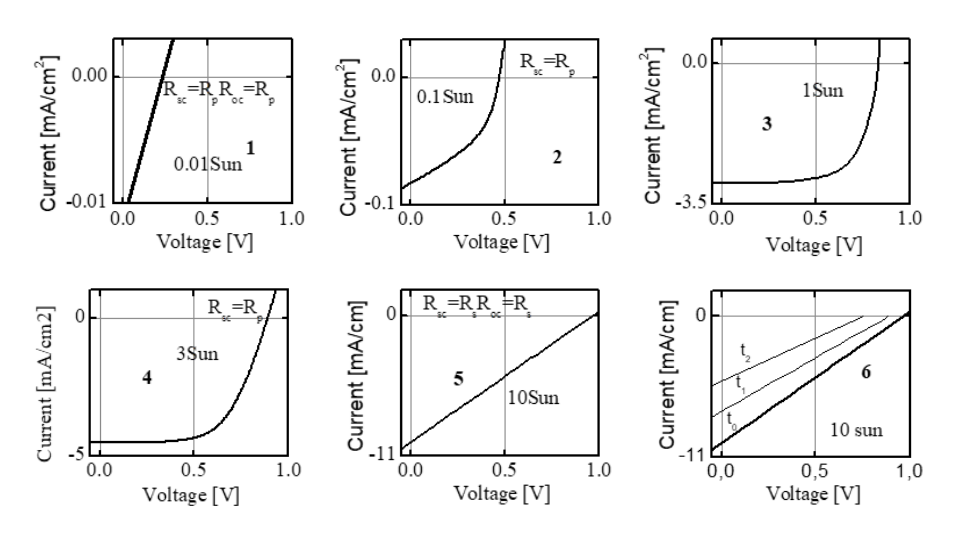Characterization of a solar cell by varying illumination
DOI:
https://doi.org/10.5604/01.3001.0014.7006Keywords:
thin films, solar cell measurement, silicon, I–V characteristic, varying illuminationAbstract
This work aims to confirm that the single-diode model of a monocrystalline cell can be used successfully also for thin-film solar cells when their basic parameters are calculated using the method of changing illumination. The authors describe the experimental procedure, in which I–V curves of thin-film solar cells are measured when illumination levels are changing. In experiments, a fully reflective 500 W solar simulator is used as an excellent broadband white light source, which provides the range of 0.01–10 Sun settings.
Downloads
References
Sze SM. Physics of semiconductor devices. New York: Wiley Interscience; 1969. Google Scholar
Wolf M, Noel GT, Stirn RJ. Investigation of the double exponential in the current—voltage characteristics of silicon solar cells. IEEE Transaction on Electron Devices. 1977;24(4):419–428. doi: https://doi.org/10.1109/T-ED.1977.18750. Google Scholar
Fahrenbruch AL, Bube RH. Fundamentals of solar cells: Photovoltaic solar energy conversion. New York–London: Academic Press; 1983. doi: https://doi.org/10.1016/B978-0-12-247680-8.X5001-4. Google Scholar
Tamrakar R, Gupta A. A review: Extraction of solar cell modelling parameters. International Journal of Innovative Research in Electrical, Electronics, Instrumentation and Control Engineering. 2015;3(1):55–60. doi: https://doi.org/10.17148/IJIREEICE.2015.3111. Google Scholar
Rhouma MBH, Gastli A. An extraction method for the parameters of the solar cell single-diode-model. 2nd European Conference on Electrical Engineering and Computer Science (EECS). 2018:433–437. doi: https://doi.org/10.1109/EECS.2018.00086. Google Scholar
Pysch D, Mette A, Glunz SW. A review and comparison of different methods to determine the series resistance of solar cells. Solar Energy Materials and Solar Cells. 2007;91(18):1698–1706. Google Scholar
Baker-Finch SC, McIntosh, KR. A freeware program for precise optical analysis of the front surface of a solar cell. 35th IEEE Photovoltaic Specialists Conference. 2010:002184–002187. doi: https://doi.org/10.1109/PVSC.2010.5616132. Google Scholar
Kołodziej A. Stability of thin film TfT’s and solar cells. Krakow: AGH University of Science and Technology; 2008. Google Scholar
Kołodziej A. Staebler-Wronski effect in amorphous silicon and its alloys. Opto-Electronics Review. 2004;12(1):21–32. Google Scholar
Hinken D, Schinke C, Herlufsen S, Schmidt A, Bothe K, Brendel R. Experimental setup for camera-based measurements of electrically and optically stimulated luminescence of silicon solar cells and wafers. The Review of Scientific Instruments. 2011;83(3):1–9. doi: https://doi.org/10.1063/1.3541766. Google Scholar
Schumacher J. Numerical simulation of silicon solar cells with novel cell structures. [doctoral dissertation]. Konstanz: Universität Konstanz; 2000. Google Scholar
Merten J. Photovoltaic with amorphous silicon: Technological, physical and technical aspects. [doctoral dissertation]. Barcelona: Universitat de Barcelona; 1996. Google Scholar
Kołodziej A, Krewniak P, Nowak S. Improvements of thin silicon solar cell efficiency. Opto-Electronics Review. 2003;11(4):281–289. Google Scholar
Yang Y, Xu G, Zhang K, Zhang X, Shen H, Altermatt PP, Ver-linden PJ, Feng Z. Analysis of series resistance of industrial crystalline silicon solar cells by numerical simulation and analytical modelling. European Photovoltaic Solar Energy Conference. 2013;28:1558–1561. Google Scholar
Kołodziej A. Raport 2016 for the NCN [unpublished]. Contract no. NCN/2011/01/B/ST7/06005. Google Scholar
Kishore R. Accurate analytical expressions for the parameters of the single exponential model of the solar cells. Solid-State Electronics. 1989;32(6):493–495. doi: https://doi.org/10.1016/0038-1101(89)90032-4. Google Scholar
Fong KC, McIntosh KR, Blakers AW. Accurate series resistance measurement of solar cells. Progress in Photovoltaics. 2011;21(4):490–499. doi: https://doi.org/10.1002/pip.1216. Google Scholar
Wronski CR, von Roedern B, Kołodziej A. Thin-film Si:H-based solar cells. Vacuum: Surface Engineering, Surface Instrumentation and Vacuum Technology. 2008;82:1145–1150. doi: https://doi.org/10.1016/j.vacuum.2008.01.043. Google Scholar
Kołodziej A, Kołodziej T, Kołodziej M. Low temperature manufacturing of Si nanocrystallites in the SiOx matrix applicable in solar cells. IEEE 39th Photovoltaic Specialists Conference (PVSC). 2013: 0580-0585. doi: https://doi.org/10.1109/PVSC.2013.6744218. Google Scholar
Kołodziej A, Kołodziej M, Kołodziej T. Thin film hybrid structures perovskite and silicon photovoltaic cells. Science, Technology and Innovations. 2018;2 (1):27–30. doi: https://doi.org/10.5604/01.3001.0012.1385. Google Scholar

Downloads
Published
How to Cite
Issue
Section
License
Copyright (c) 2020 University of Applied Sciences in Tarnow, Poland & Authors

This work is licensed under a Creative Commons Attribution-NonCommercial 4.0 International License.



